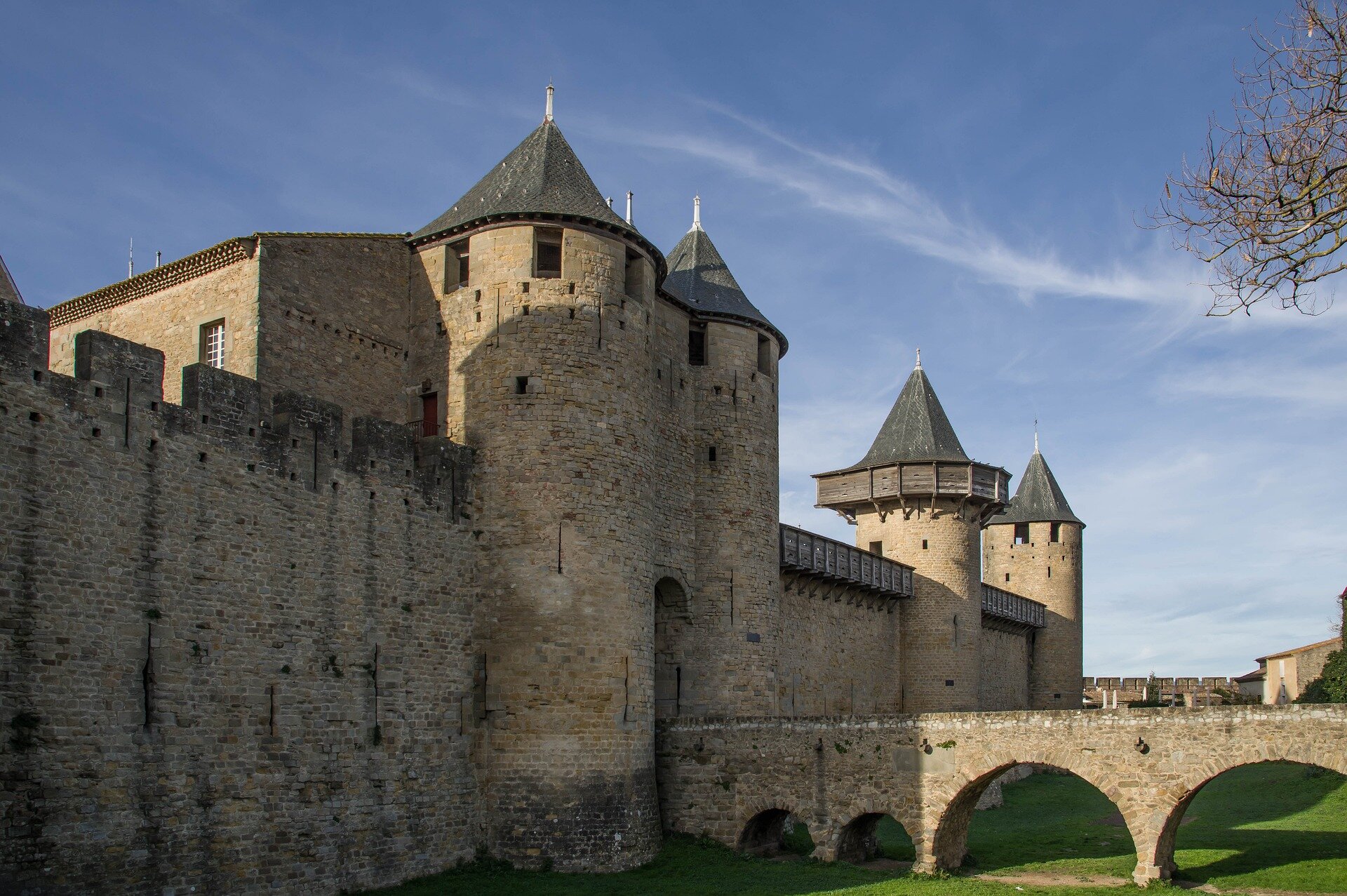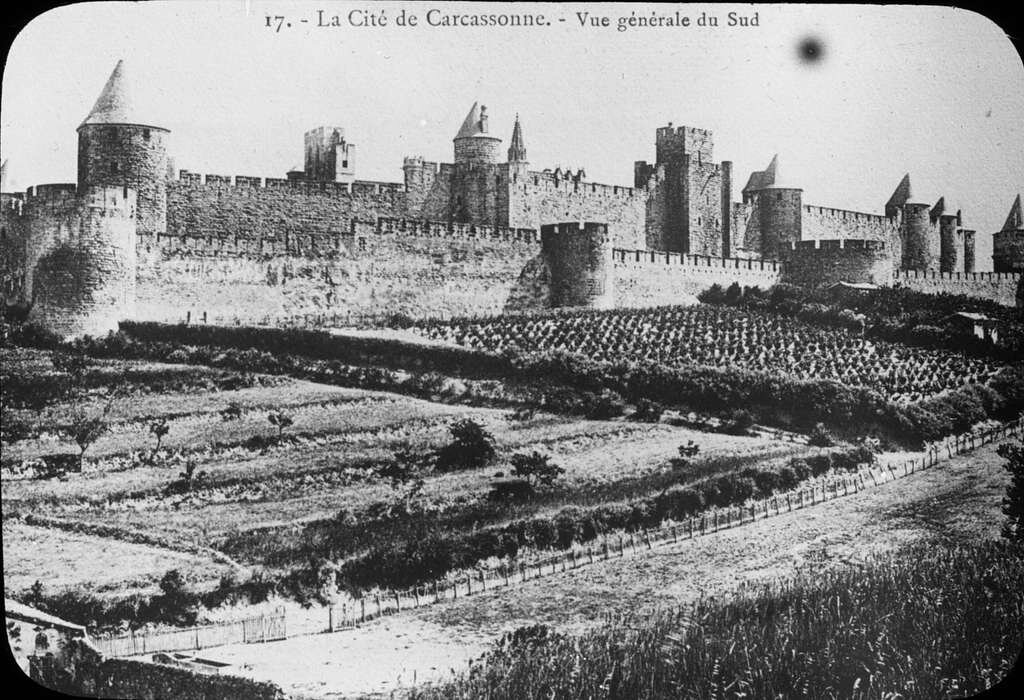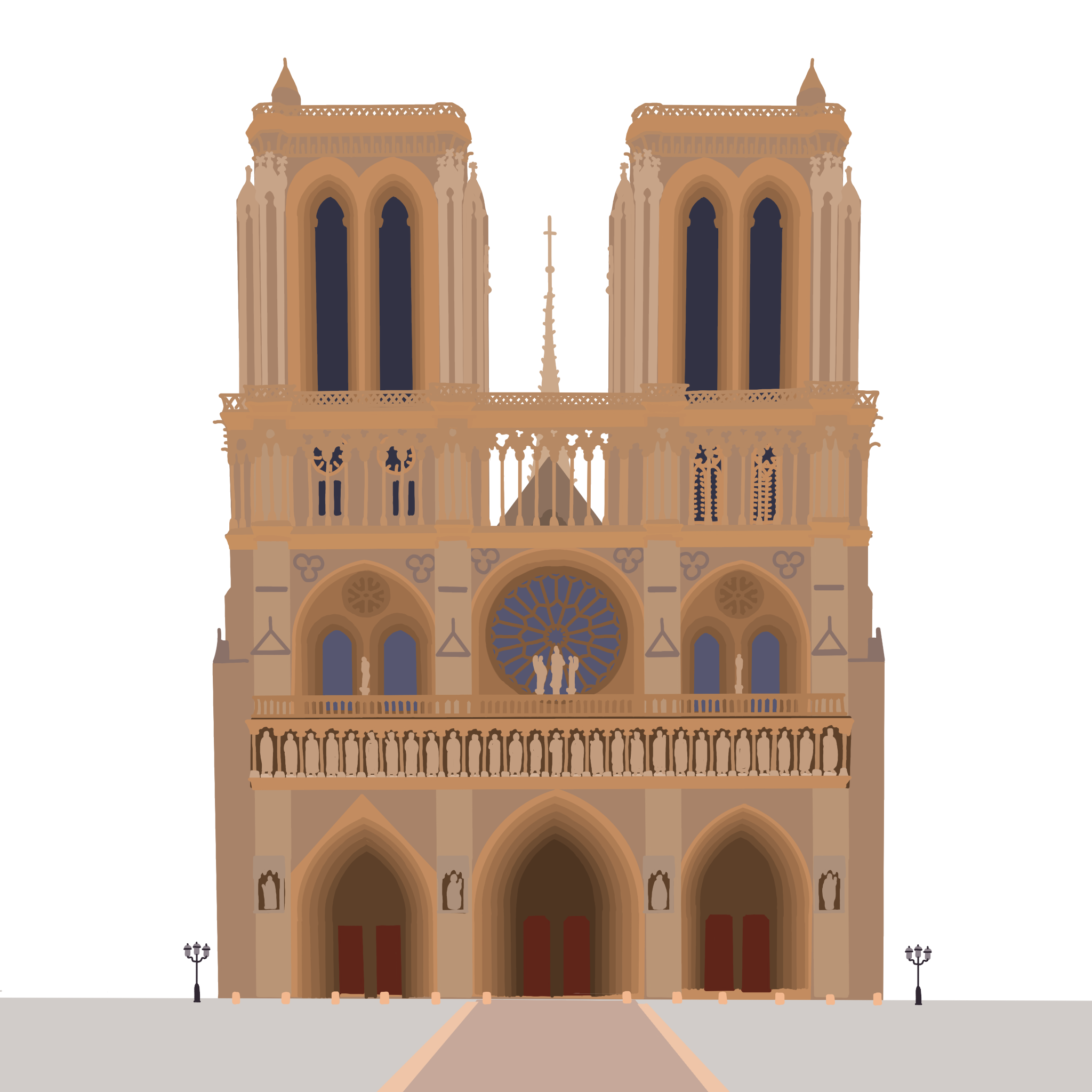Carcassonne
Travel back in time to experience the drama that went along with medieval France.
Carcassone a fascinating walled city that is still up and running today. We can pretty much thank one man for that. But his methods might be a bit questionable.
The Castle and the City
If we head back in time until we find ourselves in the BC’s and we take a look in a pretty good looking valley along the Aude River, we might see a Neolithic settlement about the place around 3500. And then around 800 we might see a little settlement on a strategically placed hill, that gave great views of the roads coming from the Mediterranean and Spain.
Throughout the 6th century BC, we see the good old Celts come on down. Known as the Volques Tectosages, the pottery and ceramics found at the site are believed to have belonged to them. Which means that ‘Carcaso’, as it was known at the time, was probably a pretty important place to trade goods.
We finally get to a dating system that moves forward and it’s during the 1st century that Carcaso is named as the capital of the Gallo-Roman colony ‘Colonia Julia Carcaso’. By this stage the city has been surrounded by ramparts making it an administrative centre, and a pretty important one at that. You can still see Roman mosaics from this time under the basement of the Count’s Castle. Pretty cool
Carcaso seemed to be the place to be, because once King Theodoric II had taken the stronghold for himself in the 5th century, we see some domestic drama with Euric coming in to murder his brother in order to become King himself. And even though Euric added an inner rampart to the city in 485 AD, sadly it wouldn’t last forever. Because Clovis I, King of the Franks, come along and attempted to take the city in 508. He failed but the Saracen invaders that came a couple hundred years after him actually did succeed. These Saracens, as Christian writers knew them were Arab Muslims who, while expanding north across Gaul, took control of the area and in turn our great city around 725.
But the Franks weren’t going to give up and it was King Pépin le Bref who came back and succeeded in taking the city for himself in 759.
Now as we move forward we do need to just point out a couple distinguishing features of the city. So the Château Comtal, the Count’s Castle, is a medieval castle that was built inside of the Cité of Carcassonne, which is the wider city enveloped by those 3 km long walls that are still standing today. Making them among Europe’s finest representation of Medieval architecture.
Because it sat in a pretty good spot, and was constantly being attacked, the city actually has two layers of walls that contain 52 towers to help in those siege situations.
While Carcassonne was a pretty important place to be and be in control of throughout the medieval period, as modern France formed and changed, the spot where you find Carcassonne became less and less essential to hold. We’ll hear more about what happened to a once great city a bit later on.
In the 11th century, Carcassonne fell into the hands of Ermengarde, the Viscountess of Agde and Béziers, and now she gets to add Carcassonne to her title. Married to a bloke called Raymond Roger Trencavel, who just happened to be the Viscount of Albi and Nîmes, these two were quite the power couple.
As Carcassonne fell through the generations, the city saw quite a couple of Viscounts. And quite quickly too I might add, none of them staying around long enough, but this is the Middle Ages, and dying young seemed to be popular.
The Viscounts, who were all Trencavels, had this knack of playing Toulouse and Barcelona, their quite powerful neighbours, off each other. They always seemed to come out on top with alliances with both, but as we know nothing lasts forever. And so it was with Carcassonne as well.
The Crusaders
When those pesky Crusaders arrived in 1209, they first started at Béziers and then worked their way up to the big guns at Carcassonne.
This Crusade, launched by Pope Innocent III, would later become known as the Albigensian Crusade.
Between the 1st and the 15th August, the Catholic Crusader Army besieged the city of Carcassonne. This would actually turn out to be just the first phase of a war that was raged against the Cathars of the Languedoc.
At Béziers, the Crusaders did something that wasn’t very Christian (shocking) and massacred the entire population. Naturally this terrified everyone else nearby.
Our current Viscount, Raymond-Roger Trencavel, was being specifically targeted by having his cities destroyed, and all because the Count of Toulouse, one of the very powerful neighbours, had joined the crusade himself, all so that the crusaders wouldn’t attack his own land. My god, the drama.
Understandably Raymond-Roger didn’t want anymore of his people massacred and so came out of his massively fortified city in order to parley with the Crusaders. The lead Crusader, some guy named Abbott-Commander Arnaud Amaury offered Raymond-Roger a truce. He could leave the city with his senior nobles and the Crusaders would take the rest.
But Raymond-Roger is thinking about everyone left inside the city and so said no to this ‘generous’ offer.
The Song of the Cathar Wars, a strongly pro-crusade epic poem written around 1210, which followed the actions of the Crusade, quite conveniently leaving out the part where Raymond-Roger is seized and taken prisoner when he didn’t comply with the truce offered by the Abbott-Commander.
Here’s an except so you know what I mean:
The Viscount of Béziers worked day and night
To defend his lands, for he was a man of great courage.
Nowhere in the wide world is there a better knight…
And all his knights and vavassors
Maintained the heretics in their castles and towers,
So they cause their own ruin and their shameful deaths.
They Viscount himself died in great anguish,
a sad and sorry loss, because of this grievous error.
Without Trencavel keeping everything together, the resistance around the city fell away and the city surrendered to the Crusade.
The Crusaders weren’t all that stupid, they had learnt from their earlier mistake at Béziers, that saw all loot destroyed when they burnt the city down. So like the gracious Christians they were (sure) they allowed the inhabitants of Carcassonne a whole day to evacuate and pretty much find somewhere else to live. This allowed them to loot everything left behind in peace.
With Raymond-Roger locked up, a certain Simon de Montfort stepped up and took it upon himself to take over all of Trencavel’s properties.
So, we have Béziers which has been razed to the ground, and we have a new Viscount of Carcassonne, and Crusaders wandering around the South of France murdering and pillaging like regular barbarians.
Not too long after, around the 10th November, Raymond-Roger died under some quite mysterious circumstances whilst still in prison. Believed to have been murdered by the Crusade, Pope Innocent III finally found a line and really told off those Crusaders in a strongly worded letter that actually still survives.
Raymond-Roger has already reigned for 15 years when he was killed at 24.
About 20 years later, in 1226, King Louis VIII had the fortune to add Carcassonne into his Royal domain.
Even though Raymond-Roger had died young, he had left behind a son, who as the rightful Viscount of Béziers and Carcassonne was ready to take back what was rightfully his from that good for nothing Simon de Montfort.
After his father’s death, Raymond II went to live with family, and as we near 1240 he was ready to take back what was his, and he didn’t do to bad a job either. Even though he was so close to taking back the Viscountcy by taking Carcassonne, it was not to be.
After Raymond Junior has failed to take the city, he did the only thing that could be done and broke his family seal in front of the King of France as a symbol of his submission. Once a great House, we never hear of the Trencavels again and they are lost to history.
After all the plundering, the Roman Catholic Church figured out a much easier way to keep the people under control. That’s right, you guessed it. The Roman Inquisition.
Not that different from the Spanish Inquisition, just appearing a couple of centuries earlier, the Roman Inquisition was mainly run by the Dominican order, which was founded by a guy called Dominic Guzman, who clearly loved naming things after himself.
Even though the Inquisition travelled around, they did have a permanent set up for a while at Carcassonne.
The Inquisition was a fan of trying new things, and so had quite a range of punishments, from only giving prisoners bread and water until they starved to death, to creatively figuring out how to create more room for more prisoners.
To create enough prison space inquisitors at Carcassonne would wall up their victims – a punishment known as strict immuration.
And all of this happened in one of the Roman Towers, which is now known as ‘The Inquisition Tower’.
The whole reason for the inquisition was to prevent the spread of religious movements that had been denounced by the Catholic Church, like those of the Cathars or Waldensians.
We have an extract from a 1285 letter written by a Dominican Inquisitor describing their work within the tower:
You have created a prison called ‘The Wall’, which would be better called ‘Hell’. In it you have constructed small cells to inflict pain and to mistreat people using various types of torture Some prisoners remain in fetters … and are unable to move. They excrete and urinate where they are … Some are placed on the chevelet [an instrument of torture]; many of them have lost the use of their limbs because of the severity of the torture … Life for them is an agony, and death a relief. Under these constraints they affirm as true what is false preferring to die once than to be thus tortured multiple times.
As we move past the Crusade and into the 17th century, we see wars come and go, with Carcassonne standing tall and strong through it all, remaining an important vantage point and defensive fortification on the French border with Spain. But after the Franco-Spanish War was ended with the signing of the Treaty of the Pyrenees, we see the Spanish border pushed much further south, meaning that Carcassonne's strategic importance pretty much vanished.
By the 18th century, Carcassonne isn’t really doing much just hanging around and so is abandoned and left to do what it will.
The restorations
So as we get into the 19th century, Carcassonne is now pretty slum-like, there’s poverty and just general decay.
In the 1840s, people weren’t all that interested in old buildings like they are now. But a young councillor working in Carcassonne who had the unpopular hobby of looking after old buildings, managed to at least get the ancient basilica of Saint Nazaire named as a historic monument, so at least one building was covered when a couple years later the whole city was nearly destroyed.
When Napoleon was hanging around he removed Carcassonne from the list of official fortifications and so the city fell into even more disrepair. So much so that the French government thought it would just be a whole lot easier to get rid of the whole thing in 1849.
But the people weren’t having it and Jean-Pierre Cros along with France’s Inspector of Historic Monuments, Prosper Mérimée set about to save the city. Because the Saint Nazaire basilica was already classed as a historic monument, is wasn’t too difficult for Cros and Mérimée to have the ‘historic monument’ title expanded to include the whole city.
Before this had all started, Mérimée had actually already written about Carcassonne in 1835, saying:
The old town is more interesting [than the new town]. Its double row of medieval fortifications could be the subject of major studies into medieval military architecture.
In order to restore Carcassonne, Mérimée had only one guy in mind. A gothic revival architect that went by Eugene Viollet-le-Duc. He’s already taken on the restorations of Mont Saint Michel in Normandy and Nôtre-Dame in Paris.
And so it was in 1853 that Viollet-le-Duc went to work. But Viollet-le-Duc didn’t look at restoration as we do now. These days when we think of a restoration, we think of restoring something to working order, and stopping there. Oxford’s Dictionary even defines ‘restoration’ as:
The work of repairing and cleaning an old building, a painting, etc. so that its condition is as good as it originally was.
Viollet-le-Duc had a similar definition that went on to say ‘make improvements along the way’.
Born in Paris, Viollet-le-Duc had an idea of how medieval buildings should look, and so while the essence of Carcassonne is genuine medieval, everything kinda got medieval embellishments that weren’t necessarily used in the Languedoc region when Carcassonne was originally built.
For example, the sloping slate roofs of the towers are more akin to Brittany. Before Viollet-le-Duc ‘fixed’ them, the tower roof would have been flat with red ‘Roman’ tiles that you see around the South of France.
This criticism of Viollet-le-Duc using his ‘artistic licence’ has followed him around, just wait until we get around to doing an episode on Nôtre-Dame, we’ll meet him there too with his embellishments, he even goes so far as to redo things.
But some defend Viollet-le-Duc saying that everything there is genuinely from the Middle Ages, he didn’t create something that wasn’t already there, just added on little bits here and there.
So anyway, because of Viollet-le-Duc’s ‘restoration’, Carcassonne was saved and now named as a historic monument, which means it isn’t going anywhere fast. Meaning that you can see an example of a working fortified medieval city today in the 21st century.
Carcassonne today
If you wander over to Carcassonne today, you will still see people living inside the city. The whole thing is still inhabited and works like any other ancient city in Europe, a combined tourist attraction and liveable space.
There are actually 50 permanent residences within the city walls. And you can even stay within the city, at the local bed and breakfast. The owner Jacqui Belter says
Most tourists are not aware that there are people living here. They tend to think it is purely a tourist attraction.
but the city kinda works more like the Tower of London.
Finally added the UNESCO World Heritage Site list in 1997, which is like super recent. UNESCO says this of Carcassonne:
In its present form it is an outstanding example of a medieval fortified town, with its massive defence encircling the castle and the surrounding buildings its streets and its fine Gothic cathedral.
And Carcassonne truly hasn’t been forgotten by the tourists either, it actually competes with Mont Saint Michel for being the most visited monument in all of France. And with a reported 4 million people stopping by every year, I think it’s in with a pretty good chance.
And to end the episode we have the translation of a song by the French songwriter, Gustave Nadaud, about a man who dreams of seeing Carcassonne before he dies. The first stanza goes like this:
I’m growing old, I’m sixty years;
I’ve laboured all my life in vain.
In all that time of hopes and fears,
I’ve failed my dearest wish to gain.
I see full well that here below
Bliss unalloyed there is for none
My prayer would else fulfilment know –
Never have I seen Carcassonne!
For those in the UK - click here
-
The beauty steeped in blood - Daily Mail Australia
Anthony Horowitz in Carcassonne - The Telegraph
Medieval marvel: Carcassonne packed with history - Times Colonist
Europe’s largest Medieval Fortified city was defended by Straw Soldiers - Ancient Origins
Outrage over artists’ contribution to France’s Carcassonne Castle - News.com.au
Fire damages tower in medieval French city Carcassonne - The Connexion
How to Spend a day in fascinating Carcassonne, France - Travel Awaits
-
Château Comtal de Carcassonne - Cathar Castles
10 Amazing Facts about the French Medieval City Carcassonne - Five Minute History
History of Carcassonne - Mescladis
Carcassonne History - Tourism Carcassonne
The Song of the Cathar Wars - Ed. Janet Shirley
Carcassone By Gustave Nadaud - Wiki Quote
Carcassonne: The walled city - About France
Medieval Carcassonne, a castle and cobblestone walkabout - Aude Tourism
Historic Fortified City of Carcassonne- UNESCO
Disclosure: As an affiliate marketer, we may receive a commission on products that you purchase through clicking on links within this website.






















